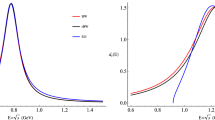Abstract
The formulation of manifestly covariant relativistic statistical mechanics as the description of an ensemble of events in spacetime parametrized by an invariant proper-time τ is reviewed. The linear and cubic mass spectra, which result from this formulation (the latter with the inclusion of anti-events) as the actual spectra of an individual hadronic multiplet and hot hadronic matter, respectively, are discussed. These spectra allow one to predict the masses of particles nucleated to quasi-levels in such an ensemble. As an example, the masses of the ground-state mesons and baryons are considered; the results are in excellent agreement with the measured hadron masses. Additivity of inverse Regge slopes is established and shown to be consistent with available experimental data on the D meson and Λc baryon production.
Similar content being viewed by others
REFERENCES
D. G. Currie, J. Math. Phys. 4, 470 (1963); D. G. Currie, T. F. Jordan, and E. C. G. Sudarshan, Rev. Mod. Phys. 35, 350 (1963).
T. D. Newton and E. P. Wigner, Rev. Mod. Phys. 21, 400 (1949).
R. Arshansky and L. P. Horwitz, Found. Phys. 15, 701 (1985).
N. Shnerb and L. P. Horwitz, Phys. Rev. A 48, 4068 (1993).
W. Pauli, Theory of Relativity (Pergamon, Oxford, 1958).
L. P. Horwitz, W. C. Schieve, and C. Piron, Ann. Phys. (N.Y.) 137, 306 (1981).
L. Burakovsky and P. Horwitz, Physica A 201, 666 (1993).
J. I Kapusta, Finite-Temperature Field Theory (Cambridge University Press, Cambridge, 1989).
H. J. Borchers and R. N. Sen, Comm. Math. Phys. 21, 101 (1975).
H. Narnhofer, M. Requardt, and W. Thirring, Comm. Math. Phys. 92, 247 (1983).
E. C. G. Stueckelberg, Helv. Phys. Acta 14, 372, 588 (1941); 15, 23 (1942).
L. P. Horwitz and C. Piron, Helv. Phys. Acta 46, 316 (1973).
R. Arshansky, L. P. Horwitz, and Y. Lavie, Found. Phys. 13, 1167 (1983).
L. Burakovsky, Found. Phys. 28 (1998).
L. Burakovsky, L. P. Horwitz, and W. C. Schieve, Found. Phys. Lett. 10, 503 (1997).
E. V. Shuryak, The QCD Vacuum, Hadrons and the Superdense Matter (World Scientific, Singapore, 1988).
L. Burakovsky and L. P. Horwitz, Found. Phys. Lett. 9, 561 (1996).
L. Burakovsky and L. P. Horwitz, Found. Phys. Lett. 10, 61 (1997).
L. Burakovsky and L. P. Horwitz, Nucl. Phys. A 614, 373 (1997).
L. Burakovsky and L. P. Horwitz, Found. Phys. 25, 1127 (1995).
D. E. Miller and E. Suhonen, Phys. Rev. D 26, 2944 (1982).
S. Okubo, Prog. Theor. Phys. 27, 949 (1962); 28, 24 (1962); M. Gell-Mann and Y. Ne’eman, The Eightfold Way (Benjamin, New York, 1964).
L. Burakovsky and L. P. Horwitz, Nucl. Phys. A 609, 585 (1996).
R. M. Barnett et al., Phys. Rev. D 54, 1 (1996).
L. Burakovsky, T. Goldman, and L. P. Horwitz, Phys. Rev. D 56, 7119 (1997).
L. Burakovsky and L. P. Horwitz, J. Phys. A 27, 4725 (1994).
G. Veneziano, Nuovo Cimento A 57, 190 (1968).
J. Pasupathy, Phys. Rev. Lett. 37, 1336 (1976); K. Igi, Phys. Lett. B 66, 276 (1977); Phys. Rev. D 16, 196 (1977).
K. Kawarabayashi, S. Kitakado, and H. Yabuki, Phys. Lett. B 28, 432 (1969).
R. C. Brower, J. Ellis, M. G. Schmidt, and J. H. Weis, Nucl. Phys. B 128, 175 (1977).
N. A. Kobylinsky, E. S. Martynov, and A. B. Prognimak, Ukr. Phys. Zh. 24, 969 (1979).
V. V. Dixit and L. A. Balazs, Phys. Rev. D 20, 816 (1979).
K. Igi and S. Yazaki, Phys. Lett. B 71, 158 (1977).
L. Burakovsky, T. Goldman, and L. P. Horwitz, Phys. Rev. D 56, 7124 (1997).
L. Burakovsky, T. Goldman, and L. P. Horwitz, J. Phys. G 24, 771 (1998).
L. Burakovsky, T. Goldman, and L. P. Horwitz, New Quadratic Mass Relations for Heavy Mesons, FERMILAB-PUB-97-265-T (hep-ph/9708468).
M. Aguilar-Benitez et al., Phys. Lett. B 161, 400 (1985).
S. Berlag et al., Z. Phys. C 49, 555 (1991).
G. A. Alves et al., Phys. Rev. Lett. 69, 3147 (1992).
S. Aoki et al., Prog. Theor. Phys. 87, 1315 (1992).
S. Berlag et al., Phys. Lett. B 247, 113 (1990).
Rights and permissions
About this article
Cite this article
Burakovsky, L. Relativistic Statistical Mechanics and Particle Spectroscopy. Foundations of Physics 28, 1577–1594 (1998). https://doi.org/10.1023/A:1018890402963
Issue Date:
DOI: https://doi.org/10.1023/A:1018890402963




